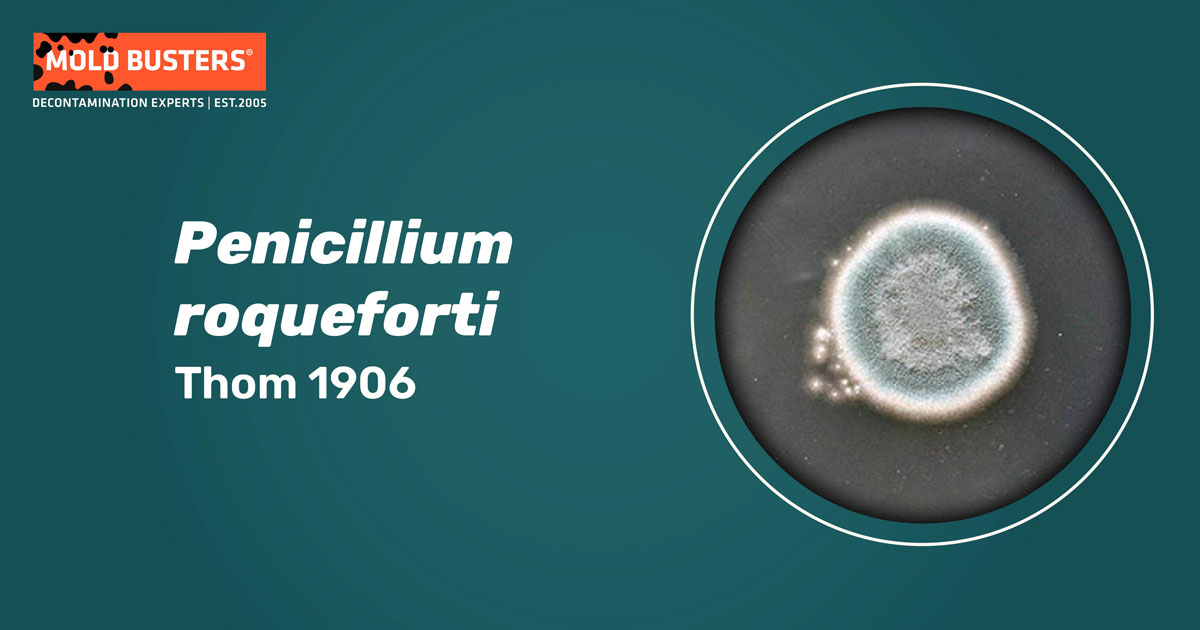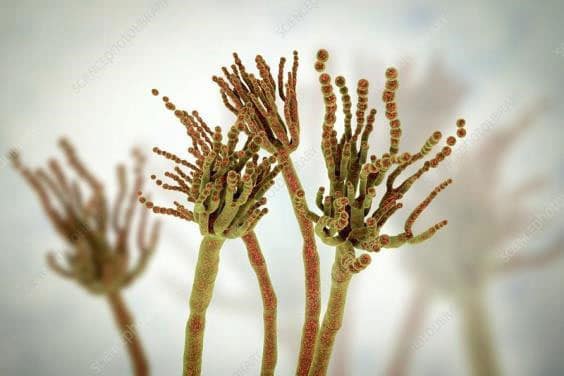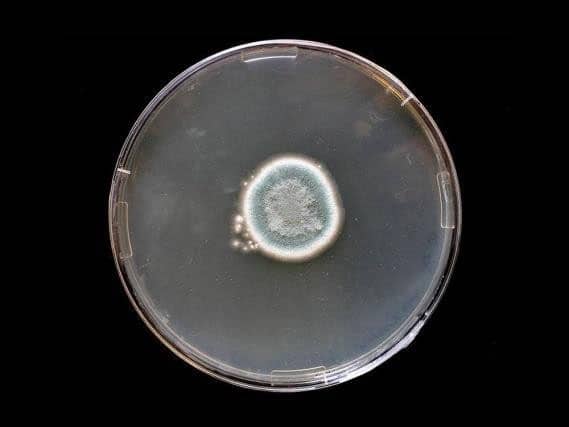Thom 1906
Penicillium roqueforti is one of over 300 accepted species of the Penicillium genus. When viewed under a microscope, the conidiophore, which produces asexual spores, resembles the shape of the brush, so the name Penicillium comes from the Latin word “penicillus,” which means brush pencil.

It is a saprophytic fungus that grows in natural environments (forest, soil, wood, and plant parts) (1). This species is significant for industrial uses for the production of blue cheeses, flavoring agents, antibacterials, polysaccharides, proteases, and other enzymes (2). P. roqueforti creates colonies on a nutritious substrate whose color varies from pale yellow to dark grayish-green. (3).


Where can Penicillium roqueforti be found?
P. roqueforti was originally isolated in Roquefort-Sur-Soulzon in France. It was later discovered that this species has a worldwide distribution. These fungi can inhabit a wide variety of substrates in the natural environment, mainly in soils rich in decomposing plant material. It can also grow on tree roots, trunks, and fruits.
Penicillium roqueforti taxonomy
More than 70 additional species have been described for the genus Penicillium since Raper and Thom’s work. Years ago, the taxonomy was related to a constancy of morphological features as size and morphology of individual conidia, colony color, and phialide shape. Still, scientists realized that some of these characteristics depend on the medium used to culture the fungus. There were improvements in a taxonomy based on physiological characters, DNA/DNA hybridization, ribosomal RNA sequences, and the production of unique arrays of secondary metabolites (2).
Today, Penicillium roqueforti belongs, within the Penicillium genus to the Roquefortorum section with other species such as P. carneum, P. paneum and P. phychrosexualis. This group was reclassified based on molecular analyses and divided into two varieties – cheese-making and patulin-making. Based on these characteristics, P. rogueforti was reclassified into three species: P. roqueforti, P. carneum, and P. paneum(4).
P. roqueforti reproduction
P. roqueforti, like other species in the genus Penicillium, is characterized by asexual reproduction. This type of reproduction is achieved through the production of spores on the conidia-bearing structure called a conidiophore. The spores can germinate without their fertilization has occurred. So far, the sexual state of this species has not yet been discovered in nature. However, under laboratory conditions, scientists have succeeded in inducing the creation of reproductive structures as well as sexual reproduction (5).
P. roquefotri mold
This is one of the rare microaerophilic fungi, which meant that it has a low oxygen requirement and can grow at high carbon dioxide concentrations. These conditions are compatible with the conditions encountered in blue cheese veins. Temperature significantly affects the formation of mold. The optimal growth temperature is 25℃. It cannot grow above 35℃, but can still grow well at temperatures as low as 5℃. The optimum pH is 6.0 (1).
The mold colonies grow rapidly and the color is blue-green, later becoming darker. Often the colors can vary from pale yellow to dark grayish-green. P. roqueforti produces odorless colonies (7). This mold has not only positive but also negative effects. It can cause spoilage of refrigerated foods, damage in corn silage, and spoil bakery goods (1).
P. roqueforti facts
- Penicillium roqueforti was accidentally discovered many centuries ago. According to legend, it happened when a shepherd from France left bread and cheese in a cave to chase after a beautiful girl. When he returned, he saw a mold on the cheese, but he didn’t know what caused it. He also notices that the cheese had a pleasant smell even though it was moldy. This species of fungi is mainly used today in the production of blue cheeses precisely because it gives them a special smell, flavor, aroma, and color (8).
- An American mycologist, Charles Thom, described P. roqueforti in 1906. (9). I addition to making cheese, this species was also used to treat gangrene for many years before Alexander Fleming isolated penicillin (8).
- The essential fact about P. roqueforti is that it is not pathogenic to plants and animals. This species does not produce penicillin which is used to make antibiotics, so it is safe for allergic people (2).
- This fungus indeed produces mycotoxins such as PR toxin and Roquefortin C, but these toxins are not harmful to people too. PR toxin is not stable in cheese and is rapidly transformed into PR imine, which is also not toxic (3). The level of Roquefortin C in cheese made from it is usually too low to produce toxic effects.
P. roqueforti benefits
Many species of the genus Penicillium are important and very useful in the industry. The most important application of this fungi is the production of different types of blue cheeses, which gives the flavor and color of these cheeses. People made these cheeses millennia ago, around 6000 BC. Today, different blue cheeses are represented in different countries: Roquefort, Fourme d’Ambert, Bleu des Causses and Bleu de Gex in France; Gorgonzola in Italy, Cabrales and Piicón de Valdeón in Spain; Stilton in the UK (3).
Penicillium roqueforti has high values of specific molecules to be considered a “multifunctional cell factory.” Products of secondary metabolism such as MPA and AND A are of interest. MPA is an immunosuppressant used to prevent transplant rejection or in psoriasis treatment. At the same time, AND A is considered to be of potential interest as an anticancer drug due to its’ inhibitory activity. Its enzyme products also are helpful (1).
In the coming decades, it might be possible to grow this fungus even in marine conditions to increase the production of high-value(6).

Did you know?
Offices in Canada are the most affected by the Basidiospores mold group?! Find out more exciting mold stats and facts on our mold statistics page.
References
- Coton E, Coton M, Hymery N, Mounier J, Jany L. (2020). Penicillium roqueforti: an overview of its genetics, physiology, metabolism, and biotechnological applications. Elsevier.
- Roqueforti (1997). Attachment I – – Final risk assessment Penicillium roqueforti. US EPA.
- Penicillium roqueforti: characteristics, habitant, Retrieved from warbletoncouncil.org.
- Boysen M, Skouboe P, Frisvad J, Rossen L (1996). Reclassification of the Penicillium roqueforti group into three species on the basis of molecular genetic and biochemical Microbiology 142(3):541-9.
- Rankovic R (2014). Sistematika Prirodno-matematički fakultet, Kragujevac.
- Mioso R, Toledo Marante J., Herrera Bravo de Laguna I (2014). Penicillium roqueforti: a multifunctional cell factory of high value-added molecules. Journal of Applied Microbiology 118:781-791.
- Samson A., Eckardt C, Orth R (1977). The taxonomy of Penicillium species from fermented cheeses. Antonie van Leveuwenhoek 43:341-350.
- Hartson W (2014). Top 10 facts about Roqueforti Retrieved from www.express.co.uk.
- Thom C (1909) Fungi in cheese ripeming; Camembert and U.S.D.A. Bureau of Animal Industry Bulletina 82:1-39.
- Larroche C, Arpah M, Gros B. (1989) Methyl-ketone production by Ca-alginate/ Eudragit RL entapped spores of Penicillium roqueforti. Enzyme and Microbial Technology 11(2):106-112.

Get Special Gift: Industry-Standard Mold Removal Guidelines
Download the industry-standard guidelines that Mold Busters use in their own mold removal services, including news, tips and special offers:

Written by:
John Ward
Account Executive
Mold Busters
Fact checked by:
Michael Golubev
General Manager
Mold Busters
